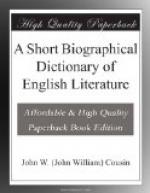WOOD, JOHN GEORGE (1827-1889).—Writer on natural history, s. of a surgeon, b. in London, and ed. at home and at Oxf., where he worked for some time in the anatomical museum. He took orders, and among other benefices which he held was for a time chaplain to St. Bartholomew’s Hospital. He was a very prolific writer on natural history, though rather as a populariser than as a scientific investigator, and was in this way very successful. Among his numerous works may be mentioned Illustrated Natural History (1853), Animal Traits and Characteristics (1860), Common Objects of the Sea Shore (1857), Out of Doors (1874), Field Naturalist’s Handbook (with T. Wood) (1879-80), books on gymnastics, sport, etc., and an ed. of White’s Selborne.
WOOLMAN, JOHN (1720-1772).—Quaker diarist, b. at Burlington, New Jersey, began life as a farm labourer, and then became a clerk in a store. He underwent deep religious impressions, and the latter part of his life was devoted to itinerant preaching and doing whatever good came to his hand. To support himself he worked as a tailor. He was one of the first to witness against the evils of slavery, on which he wrote a tract, Some Considerations on the Keeping of Negroes (1753). His Journal “reveals his life and character with rare fidelity” and, though little known compared with some similar works, gained the admiration of, among other writers, Charles Lamb, who says, “Get the writings of John Woolman by heart.” In 1772 he went to England, where he d. of smallpox in the same year.
WOOLNER, THOMAS (1826-1892).—Sculptor and poet, b. at Hadleigh, attained a high reputation as a sculptor. He belonged to the pre-Raphaelite Brotherhood, and contributed poems to their magazine, the Germ. He wrote several vols. of poetry, including My Beautiful Lady (1863), Pygmalion, Silenus, Tiresias, and Nelly Dale. He had a true poetic gift, though better known by his portrait busts.
WORDSWORTH, CHRISTOPHER (1774-1846).—Biographer, etc., was a younger brother of the poet, ed. at Camb., took orders, and became Chaplain to the House of Commons, and Master of Trinity Coll., Camb. 1820-41. He was also Vice-Chancellor of the Univ. 1820-21 and 1826-27. He pub. Ecclesiastical Biography (1810), and Who wrote Eikon Basilike? in which he argued for the authorship of Charles I.
WORDSWORTH, CHRISTOPHER (1807-1885).—S. of above, ed. at Camb., took orders and became a Canon of Westminster 1844, and Bishop of Lincoln 1868. He travelled in Greece, and discovered the site of Dodona. His writings include in theology a commentary on the Bible (1856-70), Church History to A.D. 451 (1881-83), and in other fields, Athens and Attica (1836), and Theocritus (1844).
WORDSWORTH, DOROTHY (1771-1855).—Diarist, etc., was the only sister of the poet, and his lifelong and sympathetic companion, and endowed in no small degree with the same love of and insight into nature as is evidenced by her Journals. Many of her brother’s poems were suggested by scenes and incidents recorded by her, of which that on Daffodils beginning “I wandered lonely as a cloud” is a notable example.




